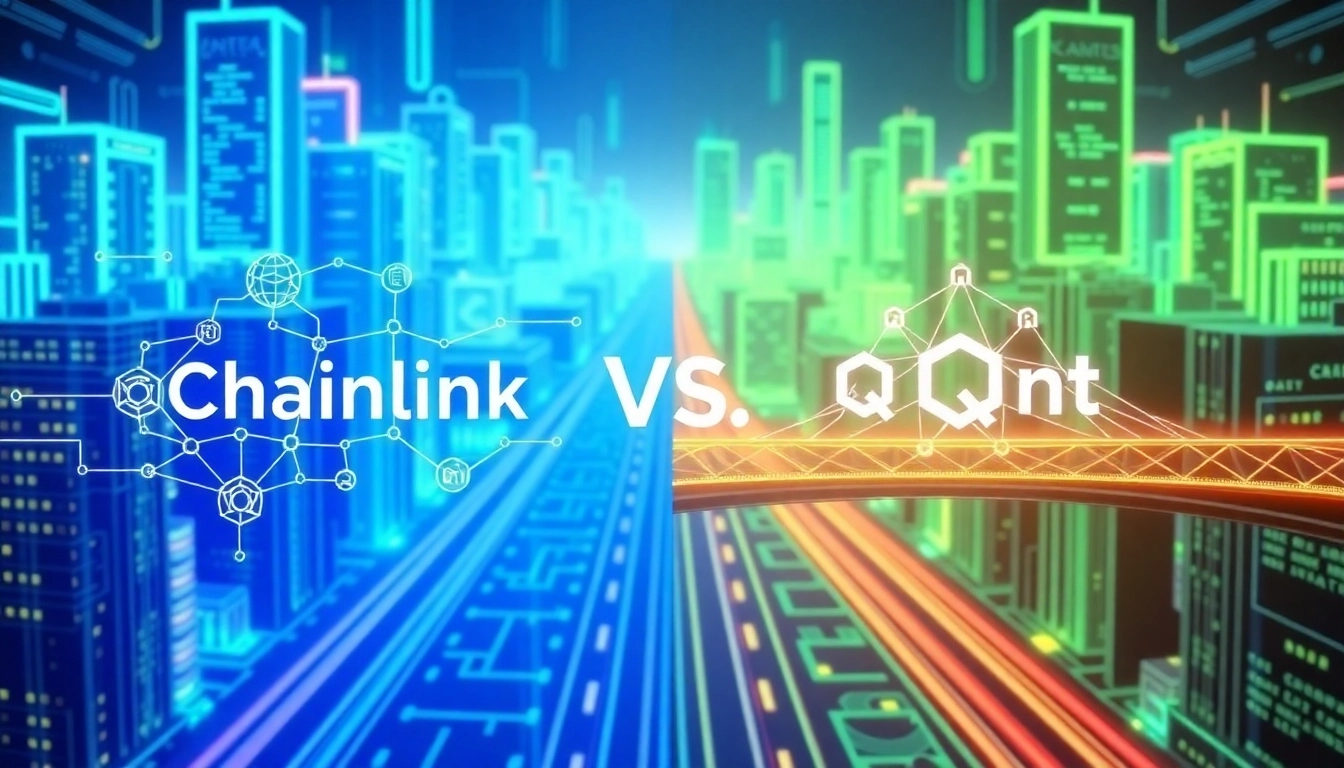Understanding Blockchain Frameworks
Introduction to Blockchain Technology
Blockchain technology has revolutionized various industries by providing a decentralized and secure way to store and transfer data. It operates on a network of computers, ensuring that no single entity has control over the entire system. This decentralized nature enhances transparency, security, and reliability, making it ideal for various applications, including finance, supply chain, healthcare, and more. Among the many innovative projects in the blockchain space, Chainlink and Quant have emerged as key players, each addressing unique issues within this broad technological landscape. The chainlink vs quant debate has gained traction as investors and developers seek to understand which solution aligns better with their needs.
Key Characteristics of Chainlink
Chainlink is a decentralized oracle network that serves as a bridge between blockchain smart contracts and real-world data. It allows smart contracts to connect to external data sources, APIs, and payment systems, thereby enhancing their functionality. Here are some essential characteristics of Chainlink:
- Decentralization: Unlike traditional oracles that are controlled by a single entity, Chainlink utilizes a decentralized network of nodes to pull data from various sources, ensuring reliability and reducing the risk of manipulation.
- Security: Chainlink incorporates security features such as cryptographic proofs and data validation to ensure the integrity of the information supplied to smart contracts.
- Interoperability: Chainlink can integrate with multiple blockchains and external systems, making it versatile for various applications across different industries.
- Trustworthiness: By leveraging its decentralized model, Chainlink provides a trustworthy solution for obtaining off-chain data, which is crucial for many smart contract applications.
Key Characteristics of Quant
Quant, on the other hand, is primarily focused on enabling interoperability between different blockchains. Its flagship technology, Overledger, allows various blockchain networks to communicate with each other seamlessly. Key characteristics of Quant include:
- Interoperability: Quant’s Overledger enables various blockchains to interact with one another, facilitating the transfer of data and assets across networks while maintaining their distinct protocols.
- Scalability: By utilizing a unique layered architecture, Quant can support a larger number of transactions without compromising speed and efficiency.
- Ease of Use: Quant’s APIs simplify the development process for businesses looking to integrate blockchain technology into their operations, reducing the barriers to entry for new users.
- Compliance Ready: Quant is designed to comply with various regulatory standards, making it more appealing to businesses in heavily regulated industries.
Differences Between Chainlink vs Quant
Functionality and Use Cases
The primary difference between Chainlink and Quant lies in their functionalities and use cases. Chainlink is designed to provide off-chain data to on-chain applications, making it essential for smart contracts that require real-time data such as market prices, weather conditions, and more. For instance, a decentralized finance (DeFi) application may use Chainlink to access current crypto prices to execute trades efficiently.
Conversely, Quant focuses on bridging different blockchain networks. Its Overledger platform allows users to build multi-chain applications that can leverage the unique capabilities of various blockchains. Use cases include cross-chain asset transfers and decentralized applications (dApps) that require functionality from diverse blockchain ecosystems.
Architecture and Design Principles
Chainlink’s architecture consists of several key components, including:
- Decentralized Oracle Network: Chainlink nodes pull data from multiple sources, enabling a decentralized approach to data acquisition.
- On-Chain Contracts: Smart contracts on the blockchain create a trustless environment, ensuring that data integrity is maintained.
- Data Aggregation: The network aggregates responses from various nodes, validating the information before it reaches the smart contracts.
In contrast, Quant’s architecture features:
- Overledger Network: A multi-chain network that facilitates communication between various blockchains.
- Layered Architecture: Distinct layers for different functionalities, improving scalability and efficiency.
- API Layer: Simplifies integration and development processes for businesses looking to utilize blockchain.
Market Position and Value Proposition
Chainlink has established itself as a leader in the oracle space, being the most widely adopted decentralized oracle solution in the market. Its value proposition lies in enhancing the functionality and reliability of smart contracts, which is critical as the demand for DeFi solutions grows.
On the other hand, Quant operates in a niche market focused on interoperability. As blockchain adoption increases, the ability to connect different networks becomes a significant value proposition. Quant aims to provide solutions that cater to businesses needing to integrate various blockchain technologies while maintaining compliance with regulations.
Advantages of Chainlink vs Quant
Benefits of Decentralized Oracles
Chainlink’s model of utilizing decentralized oracles offers several benefits:
- Reduced Risk of Single Point of Failure: The decentralized nature of Chainlink mitigates risks associated with relying on a single data source, enhancing system resilience.
- Data Accuracy: By aggregating data from numerous sources, Chainlink ensures higher accuracy and reliability of on-chain data.
- Enhanced Smart Contract Functionality: Chainlink broadens the range of applications for smart contracts, allowing them to interact with external systems effectively and reliably.
Advantages of Interoperability Solutions
Quant’s interoperability solutions also present the following advantages:
- Seamless Transactions: Facilitating smooth asset transfers and data sharing across multiple blockchain networks enhances operational efficiency.
- Innovation in DApp Development: Developers can create applications that leverage the strengths of various blockchains, fostering innovation.
- Increased Market Reach: Projects that utilize Quant’s technology can tap into diverse blockchain ecosystems, potentially reaching wider audiences.
Real-World Applications and Outcomes
Chainlink has seen extensive use in decentralized finance applications, insurance models, and supply chain logistics. For example, its integration into DeFi platforms allows for real-time price tracking, ensuring accurate and automated trading decisions. Moreover, in insurance, Chainlink can help verify real-world events (like weather data for crop insurance) to trigger automatic payouts.
Quant has implemented its technology in sectors requiring interoperability, including finance, healthcare, and logistics. Its ability to connect disparate systems promotes efficiency, reduces costs, and fosters collaboration across organizations. Case studies show that using Quant has significantly improved transaction speed and reduced costs for businesses engaging in cross-border transactions.
Challenges in Chainlink vs Quant Implementation
Technical Limitations and Solutions
Implementing Chainlink can pose certain challenges, such as data provider discrepancies and latency issues associated with data retrieval. Solutions include enhancing the validation process and increasing the number of data providers to ensure redundancy and reliability. Furthermore, utilizing advanced cryptographic techniques can enhance security measures.
Similarly, for Quant, the complexity of interoperability presents challenges like discrepancies in transaction speeds and differing consensus mechanisms. To address these issues, Quant focuses on optimizing its API and leveraging efficient routing protocols to ensure transactions occur smoothly across various networks.
Market Dynamics and Adoption Barriers
The adoption of Chainlink may be hindered by the broader cryptocurrency market’s volatility, which can affect project financing and user confidence. Overcoming this requires educating users about the reliability and capabilities of decentralized oracles while showcasing successful implementations.
Quant faces challenges related to limited awareness of its interoperability solutions and the complexity of integrating different blockchain systems. Raising awareness through case studies and partnerships can help demonstrate its value proposition and build trust among potential users.
Future Prospects for Both Technologies
Looking towards the future, Chainlink is poised to expand its functionalities to support a wider range of applications, including more complex financial derivatives and augmented reality solutions. The increasing utility of smart contracts will further enhance the need for reliable off-chain data.
Quant’s future prospects lie in its ability to remain at the forefront of blockchain interoperability. As businesses increasingly adopt multiple blockchain technologies, the demand for solutions like Overledger will likely grow, making Quant an essential player in streamlining cross-chain communications.
Making the Right Choice: Chainlink vs Quant
Factors to Consider in Decision-Making
When choosing between Chainlink and Quant, several factors should be considered, including:
- Specific Use Case: Identify the needs of your project—whether it involves smart contracts requiring real-time data or a need for interoperability among multiple blockchains.
- Development Resources: Assess the expertise available within your team to integrate either technology effectively.
- Implementation Costs: Analyze potential costs associated with implementing either solution, including transaction fees and operational expenses.
Investing Implications and Risks
Investors should consider the long-term viability and market demand for both Chainlink and Quant technologies. Market volatility, the dependency on the broader cryptocurrency environment, and regulatory developments could significantly impact investments. Careful analysis and consultation with financial advisors are advisable when considering investments in these technologies.
Conclusion and Future Directions
In conclusion, both Chainlink and Quant hold unique positions within the blockchain ecosystem. Chainlink enhances the capabilities of smart contracts through reliable data feeds, whereas Quant facilitates the seamless interaction of multiple blockchains. The choice between chainlink vs quant ultimately depends on the specific needs of the users, their projects, and the strategic goals they aim to achieve in the evolving blockchain landscape. As technology continues to advance, both Chainlink and Quant are likely to adapt and innovate, solidifying their relevance in the blockchain market for years to come.








